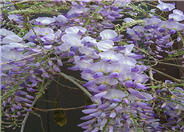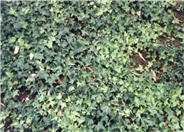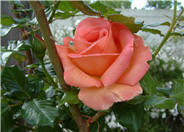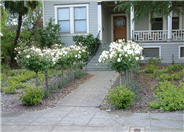
Common name:Wisteria
Botanical name:Wisteria sinensis
While the sinensis is similar to the floribunda, it bears more rounded, full clusters of strongly fragrant flowers which open more or less, all at once. There are usually 13-15 leaflets per leaf, and they require full sun and average to little watering. It comes in many colors in the blues, whites and purples.

Common name:Red Fringe Flower
Botanical name:Loropetalum chinese 'Rubrum'
Red Fringe Flower is a 6'-12' shrub with arching branches and light green and reddish leaves .

Common name:Hahn's English Ivy
Botanical name:Hedera helix 'Hahn's'
This vine takes on a more bushy form with branching at the tips; it produces amazing dark green leaves with insignificant small, white flowers.

Common name:Hybrid Tea Rose (selections)
Botanical name:Rosa Hybrid Tea varieties
These shrubs and vines are the most loved in the Western USA and are very resilient. They come in a wide variety of sizes and colors and are easy to maintain with proper care. They can be used in a water-conserving garden with careful attention to irrigation practices.

Common name:Tree Roses
Botanical name:Rosa Tree varieties
Tree roses are actually shrubs that have been grafted or grown in a way that looks like a tree, ie with a trunk. Tree roses can be floribundas, hybrid teas, or grandifloras. They are typically used as specimen plants. Make sure the plant is tied to a stake in case of strong winds.

Common name:Shasta Daisy
Botanical name:Chrysanthemum maximum
The Shasta Daisy is a favorite for beds or cut flowers with its white flowers that are 4" across with yellow centers. These flowers bloom during the spring, summer, and fall months.
Sustainable Fertilization
If you mulch heavily as recommended in the compost and mulch fact sheets you should not need traditional fertilization. Sustainable landscapes fertilize themselves as soil organisms break down and recycle the dropped leaves into nutrients.
Click in the green box for more information
| Designer: | Curbside Grand Entry |
Photographer: GardenSoft |
Soils and Compost:
Practice grass-cycling by leaving short grass clippings on lawns after mowing, so that nutrients and organic matter are returned to the soil.
Integrated Pest Management:
Remove irrigation water and fertilizer from areas where you don't want weeds to grow.

